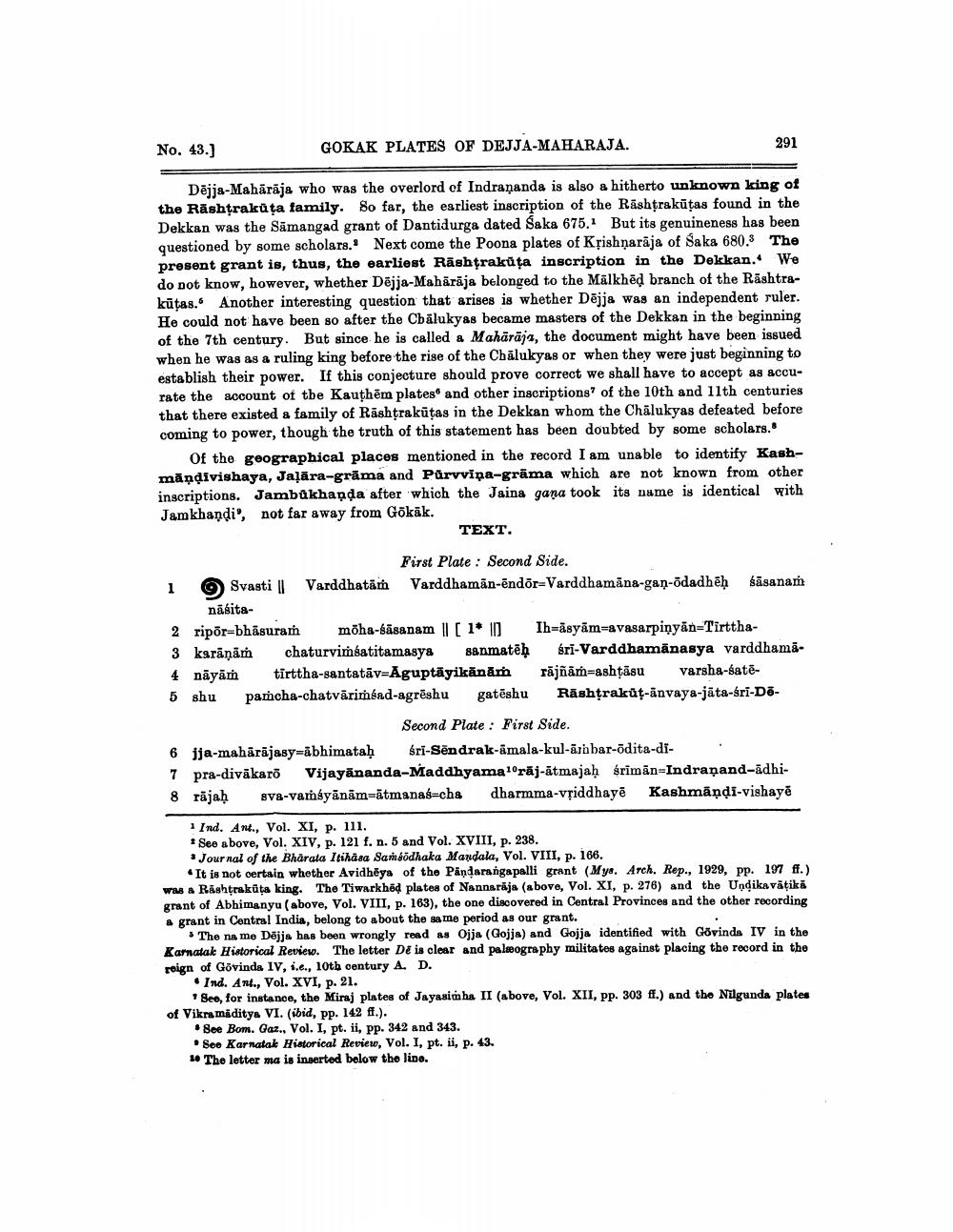________________
No. 43.]
GOKAK PLATES OF DEJJA-MAHARAJA.
Dējja-Mahārāja who was the overlord of Indrananda is also a hitherto unknown king of the Rashtrakuta family. So far, the earliest inscription of the Rashtrakutas found in the Dekkan was the Samangad grant of Dantidurga dated Saka 675. But its genuineness has been questioned by some scholars. Next come the Poona plates of Krishnaraja of Saka 680.3 The present grant is, thus, the earliest Rashtrakuta inscription in the Dekkan. We do not know, however, whether Dejja-Mahārāja belonged to the Malkhed branch of the Rashtrakūtas. Another interesting question that arises is whether Dejja was an independent ruler. He could not have been so after the Chalukyas became masters of the Dekkan in the beginning of the 7th century. But since he is called a Mahārāja, the document might have been issued when he was as a ruling king before the rise of the Chalukyas or when they were just beginning to establish their power. If this conjecture should prove correct we shall have to accept as accurate the account of the Kauthem plates and other inscriptions of the 10th and 11th centuries that there existed a family of Rashtrakutas in the Dekkan whom the Chalukyas defeated before coming to power, though the truth of this statement has been doubted by some scholars.
Of the geographical places mentioned in the record I am unable to identify Kashmāṇḍivishaya, Jalara-grāma and Pürvviņa-gräma which are not known from other inscriptions. Jambûkhanda after which the Jaina gana took its name is identical with Jamkhandi", not far away from Gōkāk.
TEXT.
First Plate: Second Side.
1 Svasti || Varddhatām Varddhaman-endōr-Varddhamana-gan-ōdadhēḥ
nāsita
2 ripōr-bhasuram mōha-sasanam || [ 1* ||]
3 karāṇāṁ chaturvimśatitamasya sanmatēḥ tirttha-santatav-Aguptayikānāṁ
4 nāyām
5 shu
291
śāsanam
Ih-asyam-avasarpinyan-Tirtthaśrī-Varddhamanasya varddhama
rājñām-ashṭāsu varsha-sate
pamcha-chatvāriméad-agrëshu gatēshu Rashtrakut-anvaya-jāta-sri-DeSecond Plate: First Side.
śri-Sendrak-amala-kul-ärnbar-ōdita-di
1 Ind. Ant., Vol. XI, p. 111.
See above, Vol. XIV, p. 121 f. n. 5 and Vol. XVIII, p. 238.
Journal of the Bharata Itihasa Sambodhaka Mandala, Vol. VIII, p. 166.
6 jja-mahārājasy-abhimataḥ
7 pra-divakaro Vijayananda-Maddhyama1oraj-atmajaḥ śrīman-Indraṇand-ädhi8 rājaḥ sva-vamsyānām-ätmanas-cha dharmma-vriddhayē Kashmaṇḍi-vishayē
It is not certain whether Avidheya of the Pandarangapalli grant (Mys. Arch. Rep., 1929, pp. 197 ff.) was a Rashtrakuta king. The Tiwarkhed plates of Nannaraja (above, Vol. XI, p. 276) and the Undikavātikā grant of Abhimanyu (above, Vol. VIII, p. 163), the one discovered in Central Provinces and the other recording a grant in Central India, belong to about the same period as our grant.
The na me Dejja has been wrongly read as Ojja (Gojja) and Gojja identified with Govinda IV in the Karnatak Historical Review. The letter De is clear and paleography militates against placing the record in the reign of Govinda IV, i.e., 10th century A. D.
Ind. Ant., Vol. XVI, p. 21.
See, for instance, the Miraj plates of Jayasimha II (above, Vol. XII, pp. 303 ff.) and the Nilgunda plates of Vikramaditya VI. (ibid, pp. 142 ff.).
See Bom. Gaz., Vol. I, pt. ii, pp. 342 and 343.
See Karnatak Historical Review, Vol. I, pt. ii, p. 43.
10 The letter ma is inserted below the line.




